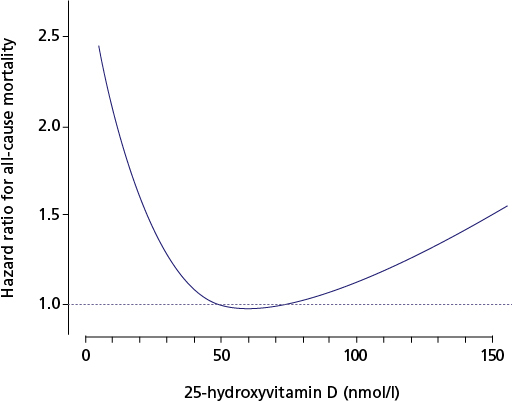Home
/ Nieuws / ...
De juiste hoeveelheid vitamine D*
Te weinig vitamine D is zeker ongezond doch teveel kan wellicht ook niet goed zijn zo blijkt uit een Deense studie. Van ruim 245.000 Denen werd bij een bezoek aan de huisarts, voor de een of andere aandoening, een bloedmonster genomen en de bloedwaarden vitamine D, calcium en PTH vastgesteld. In de drie jaar dat de deelnemers gevolgd werden stierf 6% van hen. Zij met de laagste bloedwaarden calcium, PTH en
vitamine D (< 4 mg/ml) bleken flink meer kans te hebben om dood te gaan, ruim 230%. Doch ook bij de hogere bloedwaarden calcium, PTH en vitamine D (> 56 mg/ml) bleek de kans op doodgaan verhoogd, 140%.
Verdere studies zijn nodig volgens de onderzoekers om de mogelijke oorzaken
vast te stellen omdat mogelijk ook de bestaande aandoeningen van invloed konden
zijn.

(100
nmol/l=40 ng/ml)
Vitamin D: Too Much Can Be As Unhealthy As Too Little
Scientists know that Vitamin D deficiency is not healthy. However, new research from the University of Copenhagen now indicates that too high a level of the essential vitamin is not good either. The study is based on blood samples from 247,574 Copenhageners. The results have just been published in the reputed scientific Journal of Clinical Endocrinology and Metabolism.
Vitamin D is instrumental in helping calcium reach our bones, thus lessening the risk from falls and the risk of broken hips. Research suggests that vitamin D is also beneficial in combating cardiac disease, depression and certain types of cancers. The results from a study conducted by the Faculty of Health and Medical Sciences now support the benefits of vitamin D in terms of mortality risk. However, the research results also show higher mortality in people with too high levels of vitamin D in their
bloodstream:
"We have had access to blood tests from a quarter of a million Copenhageners. We found higher mortality in people with a low level of vitamin D in their blood, but to our surprise, we also found it in people with a high level of vitamin D. We can draw a graph showing that perhaps it is harmful with too little and too much vitamin D," explains Darshana Durup, PhD student.
If the blood contains less than 10 nanomol (nmol) of vitamin per liter of serum, mortality is 2.31 times higher. However, if the blood contains more than 140 nmol of vitamin per liter of serum, mortality is higher by a factor of 1.42. Both values are compared to 50 nmol of vitamin per liter of serum, where the scientists see the lowest mortality
rate.
More studies are needed
Darshana Durup emphasises that while scientists do not know the cause of the higher mortality, she believes that the new results can be used to question the wisdom of those people who claim that you can never get too much vitamin D:
"It is important to conduct further studies in order to understand the relationship. A lot of research has been conducted on the risk of vitamin D deficiency. However, there is no scientific evidence for a 'more is better' argument for vitamin D, and our study does not support the argument either. We hope that our study will inspire others to study the cause of higher mortality with a high level of vitamin D," says Darshana Durup. She
adds:
"We have moved into a controversial area that stirs up strong feelings just like debates on global warming and research on nutrition. But our results are based on a quarter of a million blood tests and provide an interesting starting point for further research."
The largest study of its kind
The study is the largest of its kind - and it was only possible to conduct it because of Denmark's civil registration system, which is unique in the Nordic countries. The 247,574 blood samples come from the Copenhagen General Practitioners Laboratory:
"Our data material covers a wide age range. The people who participated had approached their own general practitioners for a variety of reasons and had had the vitamin D level in their bloodstream measured in that context. This means that while the study can show a possible association between mortality and a high level of vitamin D, we cannot as yet explain the higher risk," explains Darshana Durup.
Therefore in future research project scientists would like to compare the results with information from disease registers such as the cancer register. Financial support is currently being sought for such projects.
References:
University of Copenhagen (September 2012)
Printen


Reacties:
